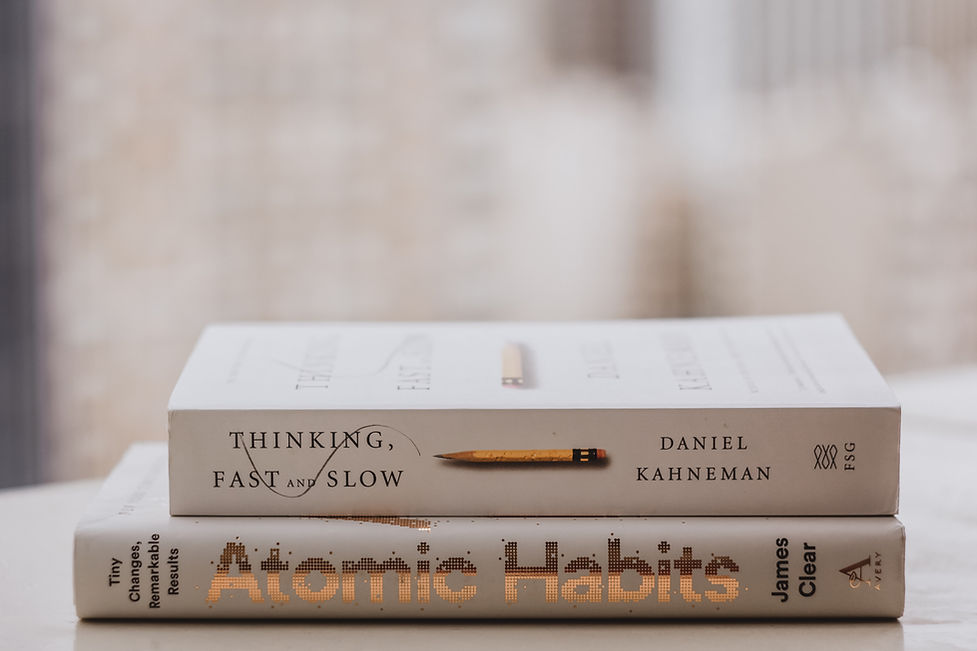

HABITS
Habits form the bedrock of our ascent on Mount Evolve, shaping our transformative journey. Cultivating positive habits nurtures growth and resilience. Each repeated action reinforces progress, leading us towards the summit. Embracing mindful habits, we create a foundation of discipline and self-awareness, propelling us to new heights. As we engrave these habits into our daily lives, we empower ourselves with the tools to navigate challenges, making the climb on Mount Evolve a deliberate and empowering path of continuous personal evolution. Each intentional habit becomes a stepping stone towards embracing our highest potential and transforming into our best selves. The ability to conquer habits will provide a revolutionary weapon in your arsenal.
WHAT ARE HABITS?
Habits are our mind's way of solving a problem in our environment so easily and effortlessly that it becomes an automatic process. Habits usually start consciously, for example, you enter a room you've never been in and look for the light. You are conscious of this process as it happens and your attention is in this moment. You find the switch and turn on the light. Problem solved. The brain stores information as a problem-solving mechanism for when we face this issue again. The next time you enter the same room you will again want to turn on the light but this time you know where it is and the process becomes quicker and a little more automatic. You're beginning to form a habit. After many times entering the same room, this process of turning on the light will be so automatic and effortless that you will do it without any awareness that you're doing it. This is when you're habits become unconscious. They are so well learnt that the body knows how to do it without the mind having to intervene much, if at all. Whilst Habits can be very helpful in situations like this, they also can hurt us.

HABITS SHAPE US
Habits help us accomplish problems in our environment so easily and effortlessly that we expend minimal energy to overcome them. This is incredibly beneficial for our survival. Habits can form over any task done with repetition via the same cues and responses, which we will come to later. Creating good habits can dramatically transform our health, whilst creating bad habits can do the complete opposite. Understanding how they form is important to creating good health. As a habit is an action done very consistently, it will quickly compound into creating a whole new version of yourself. A quote from the book Atomic Habits by James Clear, "Every action you take is a vote to whom you want to become." Your habits are your actions and your actions are shaping you to be the person you are. So we are left with a choice of whether to continue with what we have or to transform habits by creating new ones, or to break the bad ones.
UNDERSTANDING HABITS
Habits form under a process consisting of four steps.
Cue > craving > response > reward.
The cue can be caused by many different things. However, the environment usually holds a powerful cue to trigger certain habits and being mindful of this is important when it comes to changing habits.
The craving is what the body or mind wants to accomplish from the situation. You enter the kitchen in the morning, the environment and time being the cue, and you have the craving the make a cup of coffee.
The response is simply how you respond to the craving, the cue has triggered your craving for a cup of coffee and so you begin to make it.
The reward is the reason behind all habits we do. We have had the cue for the coffee, the craving triggers our response and we are left with the coffee to consume and enjoy.
We can attach many reasons to the habits we do. This is why some habits can be especially hard to create and some even harder to break.

CREATING HABITS
Now we understand the purpose behind habits and how they form we can start to create or break them. For all of these, we must understand what all four steps are involved with any particular habit we are looking to manipulate.
If your goal is to create a new habit, then you must create all four steps to work cohesively together so the habit begins to form. For example, if you want to start running you need to first create the cue. Leave your running shoes in sight for the morning or whenever you plan on running and the cue is in place. Next, the cue would trigger a craving, in this case, the craving to go running. The response would be to go running and the reward would be whatever you have attached to that, be it accomplishment, health, cardio fitness, feeling good etc.
What's important to understand here is, if one of these four steps is weak it will make it difficult to follow through with all four steps. For instance, if the cue isn't strong enough it may be that you don't even spark the next step. Or if your reward isn't a big deal for you, maybe you don't care if you run or not then it's likely the craving wouldn't even manifest. All four steps need to be strong to create a habit. Break the habit you want to create into the four steps and create it from there.
HABIT STACKING
A powerful way to create healthy new habits is to stack them onto already existing ones. We can do this by simply becoming aware of habits already integrated into our lives. These habits are established with minimal effort required for completion. We can make use of this by stacking a new habit to this. Let's have a look at an example.
Let's say you would like to add a new habit to your morning routine. First, what habits are already part of your morning routine? Brushing your teeth may be the first thing you do. If so, stack a new habit to this. Maybe you would like to meditate in the morning but can't make time, stack meditation with brushing your teeth. After you brush your teeth you go and meditate for x amount of time. Eventually, the habit of brushing your teeth will become to cue to meditation and both will become effortless.
There are infinite ways to stack habits together, anywhere, anytime. Use your imagination and use habit stacking to create new healthy habits or to transform habits already established in your life.

BREAKING HABITS
Breaking habits can be difficult. I'm sure we've all had habits we just couldn't break no matter what we did. However, after examining the nature of habits and the four steps needed to make a habit successful, we can use this information to reverse engineer one already established to transform habits and make the four steps weaker and therefore the habit becomes increasingly difficult. Let's take the example of drinking too much alcohol, maybe you want to cut down on it or stop it completely. However every night after work you end up pouring a glass of wine to relax. Let's take a look at the four steps associated with this habit.
The cue would likely be a certain time of night, maybe you've just got in from work, had a bath and dinner and want to relax with a glass of wine (or 2). Maybe the time of night is the cue, or maybe a drink with your dinner is the cue. You know there's wine in the fridge and all this triggers the next step (the craving) and the habit begins to move on from there. Identify what causes the craving in the first place.
Next, the craving kicks in, this part is hard to just ignore with willpower and motivation alone. Sometimes we will be able to say no, but what we need to understand is, that if the same cue is triggering the same craving day after day it's only a matter of time before we give in and spiral back into it. Willpower will only last so long.
Once the craving kicks in the next step would be the response to it by doing exactly what it is we want. In our example, pouring a drink.
Following the response is the whole reason why we do it in the first place. The reward. As mentioned earlier, we can attach many different things to our reward. Maybe the drink provides a sense of relaxation after a long day. Maybe you just simply love the taste. Whatever the reward is for why you do it, identify it.
Now to break it we weaken these four steps. The cue may not be easily changeable. The time of day and your routine for the evening may be more cemented, however, in our example, part of the cue is also the fact you have wine in the fridge, so you can complete the habit. If you can't change all the cues, then weaken them. Don't buy the wine in the first place, when the craving kicks in from the cue, you can't simply go to the fridge, it's not there. You can't complete the habit. Sure you could go out and get some but our goal is to weaken the steps. Going out of your way to fulfilling the habit every time is going to become increasingly more difficult, and time-consuming and eventually weaken the structure and steps, this is our goal.
The next step is the craving, this one is difficult to manage. We can sense the feeling of what it brings with our reward. We can't simply change the craving here unless we can associate a different reward with it. If we were to think of the consequence of drinking rather than the positive feeling it initially gave us then we wouldn't drink it. What we are craving is the feeling, not the action itself. So to combat this, we could contemplate why we want this feeling. Can we get it a better way? Can we live without it? This will lead us to become more aware of our habits and why we do them and can bring the more mature mind to see through it and begin to break it down. Alternatively, we could learn something else brings us that same feeling and we replace part of the habit with something else that could instantly turn a bad one into a good one, remember, we already have all four steps established in our example, if we swapped wine for a green tea we could have changed a bad habit to a good one. Or we simply demolish the habit altogether by weakening the steps as we learn it's no longer serving us.

TRANSFORM HABITS
Habits have the power to completely alter who we become. A ship's compass that is off by just 1 degree may not make much difference to the course at that moment, but as the 1 degree continues and continues he will find himself miles off course in the end. Understand this with habits. Whilst the run won't make you fit in the one session, the consistency of 1 degree in a certain direction will soon take your course to a new place. Likewise, the one drink won't hurt sure, but the consistent 1 degree in that direction will soon take you somewhere you may not want to be. Be mindful, and learn to transform habits and not be at the mercy of them.
Special thanks to James Clear and his book ATOMIC HABITS for the four-step principle referred to in this.